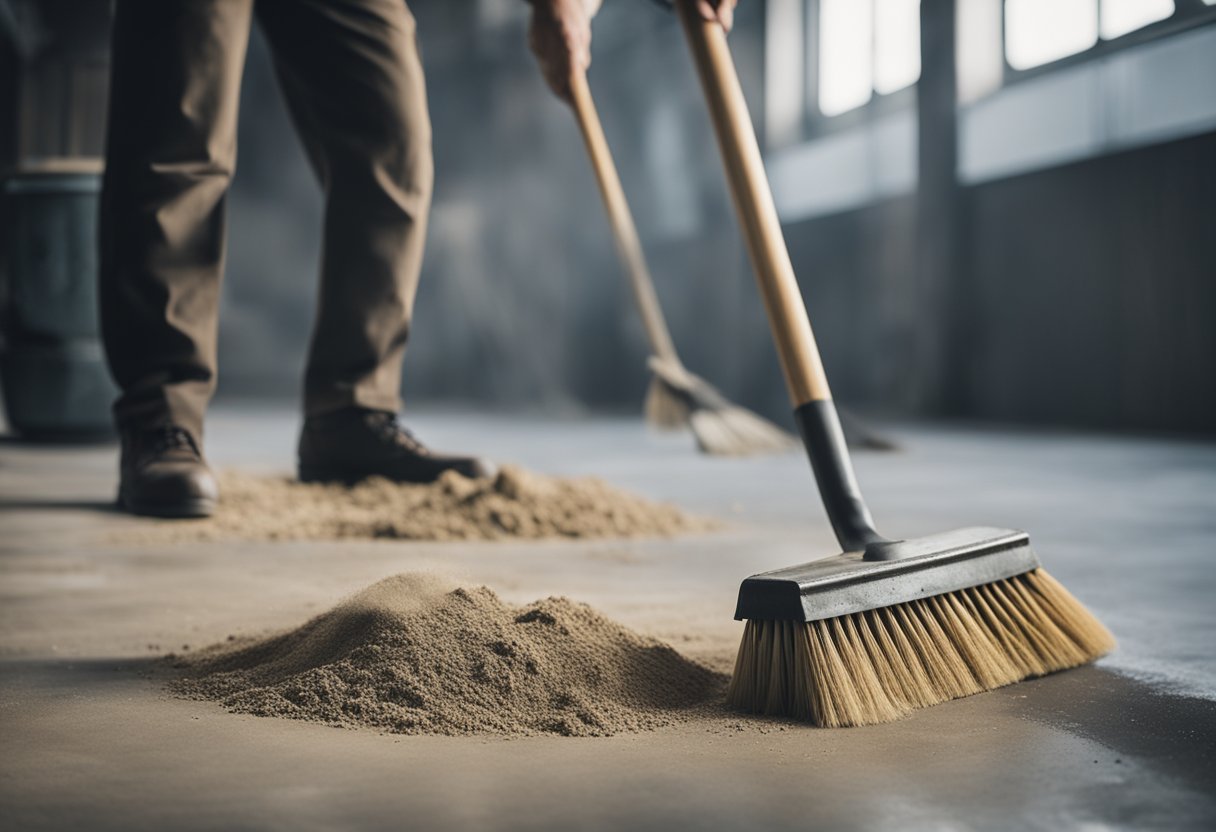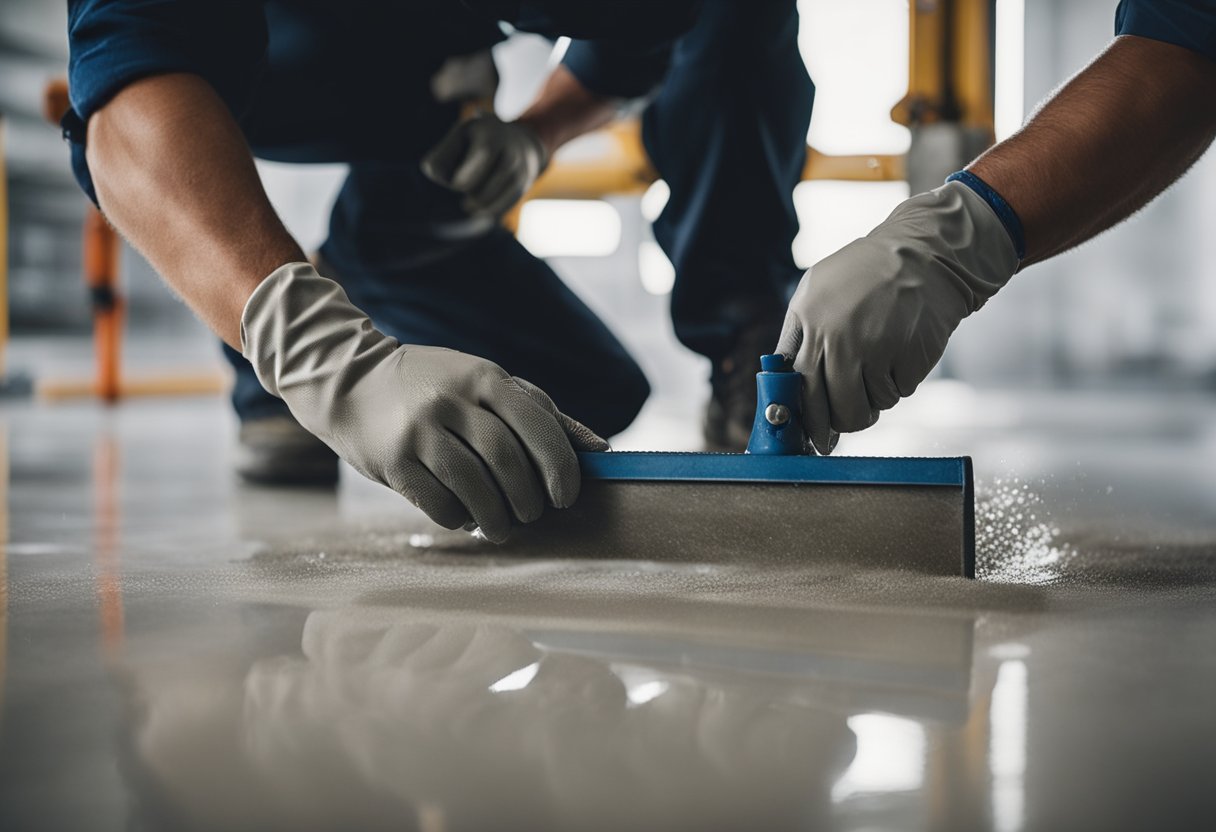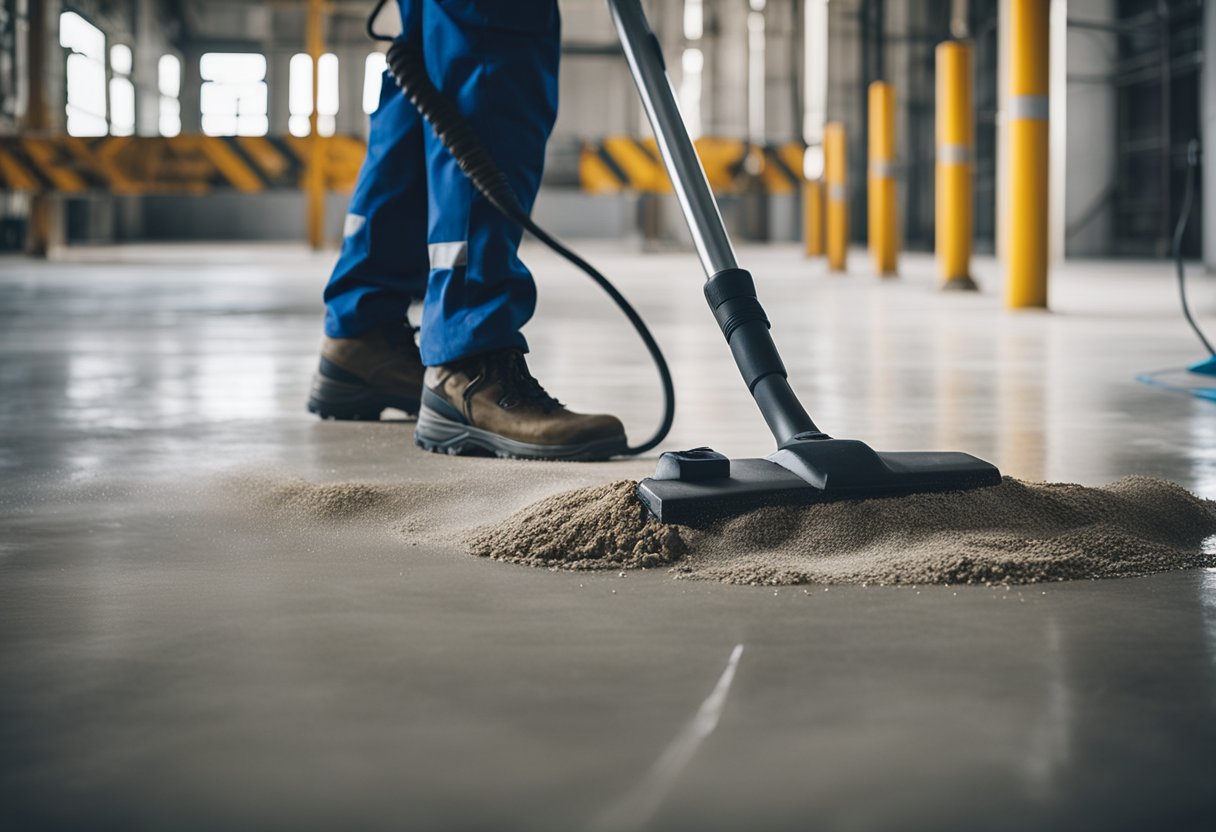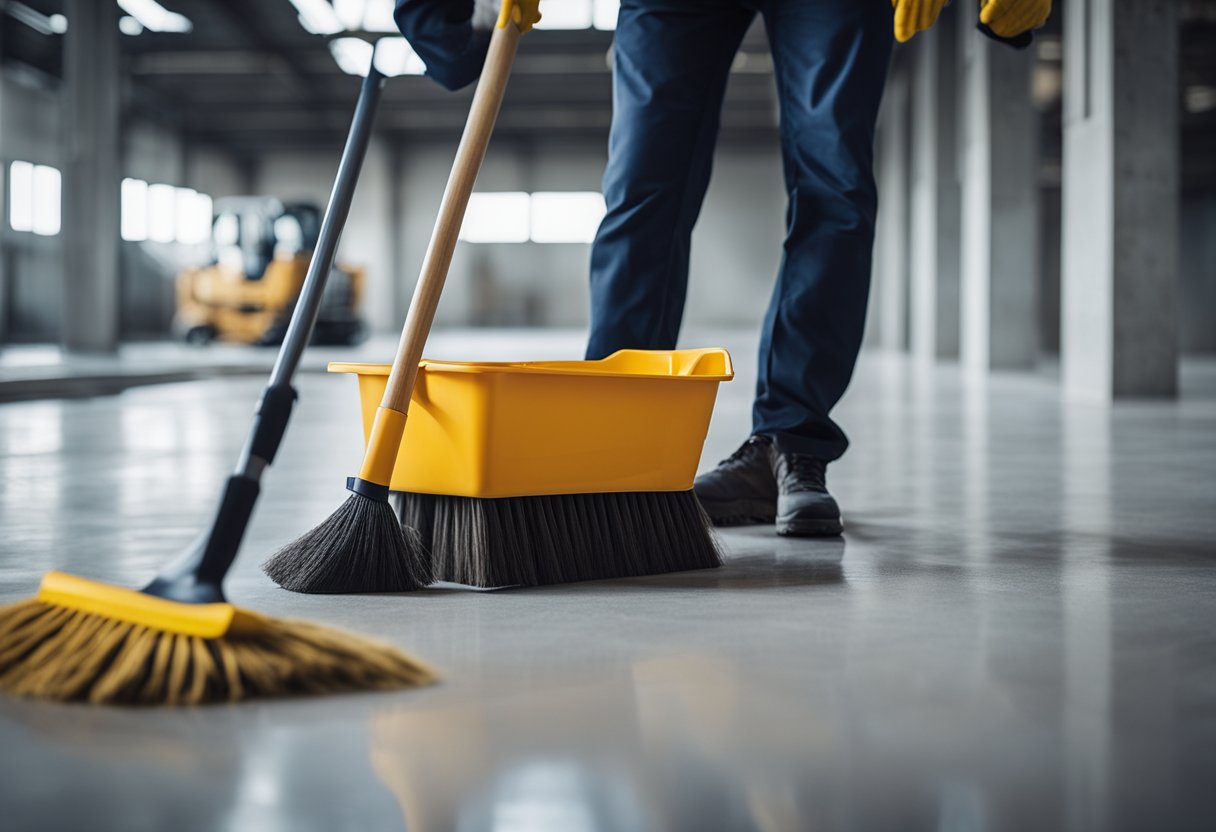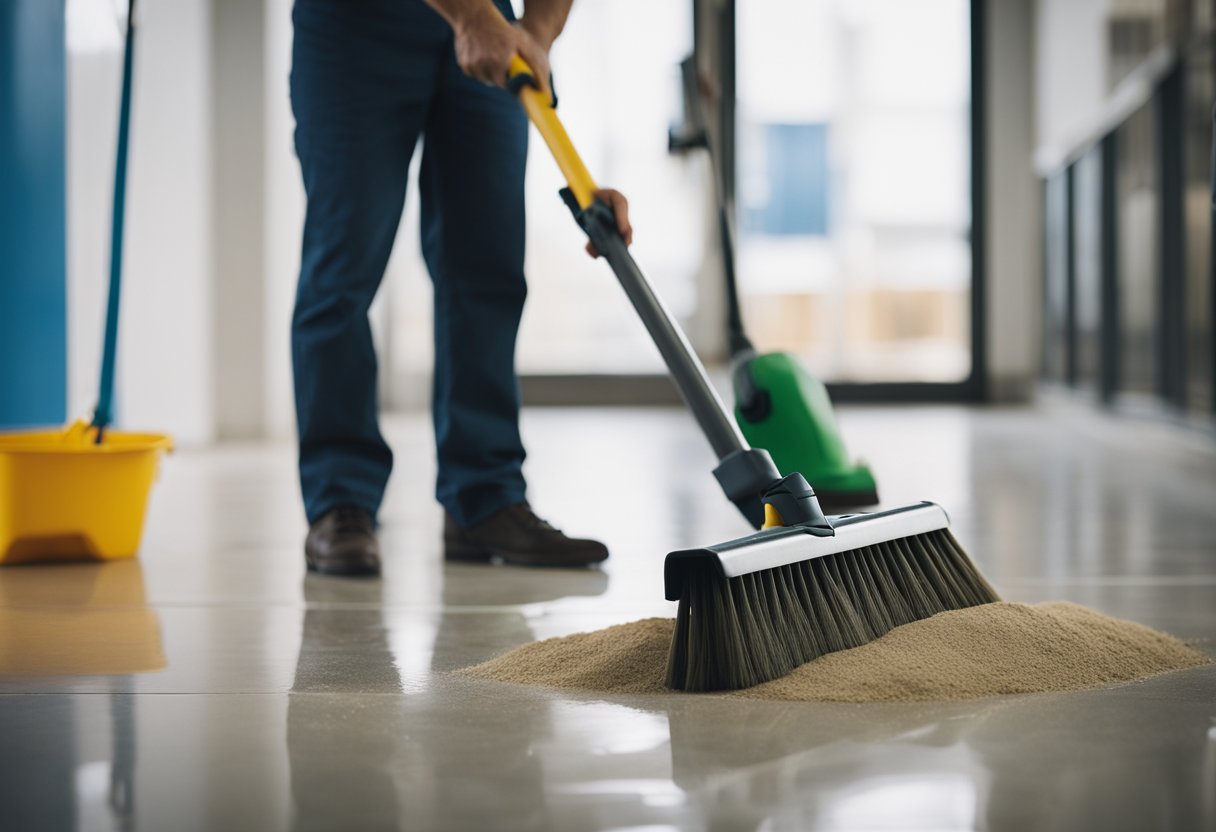Cleaning construction dust from a concrete floor can be a daunting task, especially if you don’t know where to start. However, with the right tools and techniques, you can remove the dust and restore the floor to its original condition. In this article, I will share some tips and tricks on how to clean construction dust from a concrete floor effectively.
Before we dive into the cleaning process, it’s essential to understand the nature of construction dust and concrete floors. Construction dust is a fine powder that can settle on surfaces and cause respiratory problems if inhaled. Concrete floors are porous and can absorb the dust, making it challenging to remove. Therefore, it’s crucial to take the necessary precautions and follow the correct cleaning procedures to ensure a safe and thorough cleaning process.
Key Takeaways
- Proper preparation is essential before cleaning construction dust from a concrete floor.
- Sweeping and vacuuming are the first steps of the cleaning process.
- Using special cleaning solutions and sealing the concrete floor can help prevent future dust buildup.
Understanding the Nature of Construction Dust and Concrete Floors
https://www.youtube.com/watch?v=JG0xoycnCns&embed=true
As someone who has worked in construction, I know that construction dust is a common byproduct of construction work. Construction dust is made up of various particles such as concrete, wood, fiberglass, and drywall, among others. It is usually created during the demolition, cutting, drilling, or grinding of materials.
Concrete floors are a popular choice in construction due to their durability and low maintenance. However, concrete floors can be tricky to clean, especially when they are covered in construction dust. The cleaning process will depend on whether the concrete is sealed or unsealed. Sealed concrete floors have a protective layer that prevents dust from penetrating the surface, making them easier to clean. Unsealed concrete floors, on the other hand, are more porous and prone to dust accumulation.
Plain concrete floors are the most common type of concrete floor. They are unsealed and can be difficult to clean due to their porous nature. Polished concrete floors, on the other hand, have a smooth surface that makes them more resistant to dust and easier to clean.
When cleaning construction dust from concrete floors, it is important to use the right tools and techniques to avoid damaging the surface. Using a broom or a dust mop with soft bristles is a good way to remove loose dust particles. A damp mop can then be used to clean the surface thoroughly. It is important to avoid using harsh chemicals or abrasive cleaners that can damage the surface of the concrete.
In summary, construction dust is a common byproduct of construction work that can be difficult to clean from concrete floors. Understanding the nature of construction dust and the type of concrete floor you are dealing with can help you choose the right cleaning tools and techniques to get the job done efficiently and effectively.
Preparation Before Cleaning
https://www.youtube.com/watch?v=MNffnX3HmoM&embed=true
Before starting to clean the construction dust from the concrete floor, it is essential to take some precautions to ensure your safety and the effectiveness of the cleaning process. In this section, I will outline the necessary preparation steps to take before cleaning the construction dust.
Wear Protective Clothing
It is crucial to wear protective clothing, including goggles and a dust mask, to avoid inhaling the dust particles and protect your eyes from debris. Personal protective equipment (PPE) is essential to prevent any health risks associated with the dust.
Prepare Cleaning Tools
The cleaning tools required for cleaning construction dust from concrete floors are a broom, a dust mop, a vacuum with a HEPA filter, and a clean mop. The broom and dust mop are used to remove the larger debris and dust particles from the floor, and the vacuum with a HEPA filter is used to remove the finer dust particles that the broom and dust mop missed. A clean mop is used to give the floor a final clean.
Use Plastic Sheeting
Covering any furniture or items in the room with plastic sheeting can protect them from the dust. It is also recommended to use plastic sheeting to seal off the room or area being cleaned to prevent the dust from spreading to other areas of the house.
Ensure Proper Ventilation
It is crucial to ensure proper ventilation in the room or area being cleaned. Open windows and doors to allow fresh air to circulate in the room. If possible, use a fan to help circulate the air and remove any dust particles from the room.
Hire a Contractor
If the construction dust is extensive, it may be necessary to hire a contractor to clean the area. Professional contractors have the necessary equipment and expertise to clean the area effectively and safely.
Sweeping and Vacuuming the Dust
https://www.youtube.com/watch?v=N0mH7jK0xOA&embed=true
When it comes to cleaning up construction dust from a concrete floor, the first step is to sweep and vacuum the dust. This is the most effective way to remove the bulk of the dust and dirt from the floor.
I recommend using a broom or dust mop to sweep the floor, starting from the farthest corner of the room and working your way towards the door. Be sure to sweep the dust into a pile and then scoop it up with a dustpan.
Next, use a vacuum cleaner with a HEPA filter to remove any remaining dust and dirt from the floor. A HEPA filter is important because it can capture the small particles of dust that a regular filter might miss.
You can also use a microfiber cloth to wipe down any surfaces that are covered in dust, such as countertops or shelves. Microfiber cloths are great for cleaning because they are soft and gentle, but also effective at picking up dirt and dust.
Don’t forget to clean the air vents in the room as well. Air vents can collect a lot of dust and debris, especially after any concrete work. Use a broom to sweep away any bigger bits from the vents. Then, use a wet cloth to clean up the finer particles from the vents’ surfaces. This helps ensure the dust doesn’t spread when the vents are on.
By sweeping and vacuuming the dust, you can effectively clean construction dust from a concrete floor and ensure that your space is clean and safe.
Wet Cleaning Process
https://www.youtube.com/watch?v=vUYZA8CO3Do&embed=true
When it comes to cleaning construction dust from a concrete floor, wet cleaning is one of the most effective methods. Wet cleaning involves using a mop or scrub brush to apply a cleaning solution to the floor and then rinsing it off with clean water. Here’s how to do it:
-
Start by sweeping or vacuuming the floor to remove any loose dust and debris. This will make the wet cleaning process more effective by preventing the dust from turning into a muddy mess.
-
Fill a bucket with warm water and add a mild detergent or cleaning solution. Be sure to follow the manufacturer’s instructions for dilution and use.
-
Dip a mop or scrub brush into the cleaning solution and wring it out so that it is damp but not dripping wet.
-
Begin scrubbing the floor with the mop or scrub brush, starting at one end of the room and working your way towards the other. Use elbow grease to scrub any stubborn stains or spots.
-
Once you’ve scrubbed the entire floor, rinse the mop or scrub brush in clean water and wring it out. Then, use it to rinse the floor with clean water. Be sure to change the water frequently to avoid spreading dirt and debris around.
-
Once you’ve rinsed the entire floor, use towels to dry it off. A clean concrete floor should be damp-mopped regularly to keep it looking its best and to prevent the buildup of dust and debris.
Using Special Cleaning Solutions
https://www.youtube.com/watch?v=ISDQQyAyUCw&embed=true
When it comes to cleaning construction dust from a concrete floor, using special cleaning solutions can be very effective. There are several products available in the market that can help you to clean the concrete floor of your home or office.
One of the most common cleaning solutions for concrete floors is bleach. Bleach is a powerful cleaning agent that can remove tough stains and dirt from the surface of the concrete. However, it is important to dilute bleach before using it on the floor, as it can be harmful if used in its concentrated form.
Another effective cleaning solution is vinegar. Vinegar is a natural and safe cleaning agent that can be used to remove grease stains and tire marks from the concrete floor. It is also effective in removing unpleasant odors from the floor.
Ammonia is another cleaning solution that can be used to clean concrete floors. It is particularly effective in removing stubborn stains and dirt from the surface of the concrete. However, it is important to use ammonia in a well-ventilated area, as it can be harmful if inhaled.
Trisodium phosphate (TSP) is a powerful cleaning agent that is commonly used to clean concrete floors. It is particularly effective in removing oil stains and grease marks from the surface of the concrete. However, it is important to use TSP with caution, as it can be harmful if ingested or inhaled.
Hydrogen peroxide is a natural cleaning solution that can be used to remove tough stains and dirt from the surface of the concrete. It is particularly effective in removing blood stains and other organic stains from the floor.
Muriatic acid is a strong cleaning solution that is commonly used to clean concrete floors. It is particularly effective in removing tough stains and dirt from the surface of the concrete. However, it is important to use muriatic acid with caution, as it can be harmful if not used properly.
In conclusion, using special cleaning solutions can be very effective in cleaning construction dust from a concrete floor. However, it is important to use these solutions with caution and follow the instructions carefully to avoid any damage to the surface of the concrete.
Sealing and Protecting the Concrete Floor
After cleaning the concrete floor from construction dust, it is essential to seal and protect the surface to prevent future dust accumulation. Sealing the concrete floor creates a protective layer that helps to prevent moisture, stains, and other contaminants from penetrating the surface.
There are several types of concrete sealers available in the market, including urethanes, waxes, epoxies, and coatings. Each type of sealer has its unique properties, and the choice of sealer depends on the specific needs of the floor.
Urethanes are a popular choice for sealing concrete floors because they are durable and resistant to abrasion, chemicals, and UV rays. They also provide a glossy finish that enhances the appearance of the floor. Wax is another option for sealing concrete floors, and it is relatively easy to apply. However, wax requires regular maintenance and may require frequent reapplication.
Before applying any sealer, it is essential to prepare the surface properly. The concrete floor should be clean, dry, and free of any contaminants. Any cracks or holes in the floor should be repaired before applying the sealer.
Once the surface is prepared, the sealer can be applied using a roller or sprayer. It is important to follow the manufacturer’s instructions carefully when applying the sealer. The sealer should be applied in thin coats, and each coat should be allowed to dry completely before applying the next coat.
After the sealer has been applied, it is important to maintain the surface properly. Regular cleaning with a pH-neutral cleaner and clean water will help to keep the surface clean and free of dust and debris. Rugs and floor mats can also help to protect the surface from foot traffic and other wear and tear.
In conclusion, sealing and protecting the concrete floor is an essential step in preventing construction dust accumulation. There are several types of sealers available, and the choice of sealer depends on the specific needs of the floor. Proper surface preparation, application, and maintenance are crucial to ensuring the longevity and effectiveness of the sealer.
Safety Measures and Precautions
When cleaning construction dust from a concrete floor, it is important to take safety measures and precautions to avoid any respiratory problems or other health hazards. Here are some tips to ensure your safety during the cleaning process:
-
Wear protective gear: Before starting the cleaning process, wear gloves, a mask, and protective eyewear to avoid any direct contact with the dust and debris. This will help you to avoid inhaling the dust particles and protect your skin from any harmful chemicals.
-
Ensure good air quality: Open the windows and doors to ensure good air quality and proper ventilation. This will help to reduce the concentration of dust particles in the air and prevent respiratory problems.
-
Cover ducts and vents: Cover the air ducts and vents with plastic sheets to prevent dust from spreading into other areas of the house. You can also use a spray bottle to mist the dust particles before cleaning to prevent them from becoming airborne.
-
Use a stiff-bristled brush: Use a stiff-bristled brush to scrub the surface of the concrete floor and remove any stubborn dust particles. You can also use a pressure washer to clean the floor, but make sure to keep the pressure low to avoid damaging the concrete surface.
-
Use a wet-dry vacuum: Use a wet-dry vacuum to remove the loose dust particles quickly and efficiently. Make sure to empty the vacuum bag frequently to avoid clogging.
-
Use a fan: Use a fan to help circulate the air and direct the dust particles towards the vacuum cleaner. This will help to speed up the cleaning process and prevent the dust from settling back onto the floor.
By following these safety measures and precautions, you can ensure a safe and effective cleaning process when removing construction dust from a concrete floor.
Post-Cleaning Care and Maintenance
Now that you have cleaned your concrete floor after construction, it is important to take proper care and maintenance to ensure that it remains clean and in good condition. Here are some tips to help you:
-
Regularly sweep and dust the floor to remove any dirt or debris that might accumulate on the surface. Use a duster or a soft-bristled broom to avoid scratching the surface of the concrete.
-
Use a clean water mop to remove any remaining dust or film that might have settled on the surface. Make sure to use clean water to avoid spreading any dirt or debris that might be present in the water.
-
In case of any spills or stains on the concrete surface, clean them up immediately to avoid any permanent damage. Use a mild cleaning solution and a soft-bristled brush to gently scrub the affected area.
-
For concrete surfaces that are prone to staining, such as bathroom floors, consider using a sealant to protect the surface. A sealant can help prevent spills and stains from penetrating the surface of the concrete.
-
If you have carpet or ceiling tiles in the room where the concrete floor is located, make sure to cover them with plastic sheeting before cleaning the concrete. This will prevent any dust or debris from settling on the carpet or ceiling tiles.
-
Use the right cleaning tools and materials to avoid damaging the concrete surface. Avoid using abrasive cleaners or tools that might scratch the surface of the concrete.
By following these tips, you can ensure that your concrete floor remains clean and in good condition for years to come.
Frequently Asked Questions
What is the best way to clean construction dust from a concrete floor?
The best way to clean construction dust from a concrete floor is to start by wiping down all visible surfaces with a damp cloth. Then, use a broom with soft bristles or a dust mop made for surfaces that are easy to damage to sweep the floor. After sweeping, use a damp mop for the concrete floor to ensure that dust doesn’t settle back on places you’ve cleaned.
Can you use a vacuum to clean up concrete dust?
Yes, you can use a vacuum to clean up concrete dust, but it’s important to use a vacuum with an extra filter or two to prevent the dust from getting back into the air. It’s also a good idea to use a vacuum with a HEPA filter to capture small particles.
How do you remove concrete dust from a patio?
To remove concrete dust from a patio, start by sweeping the area with a broom with soft bristles or a dust mop made for surfaces that are easy to damage. Then, use a garden hose to rinse the area with water. If the dust is stubborn, you can use a pressure washer to remove it.
What is the most effective method for cleaning concrete floors after construction?
The most effective method for cleaning concrete floors after construction is to start by wiping down all visible surfaces with a damp cloth. Then, use a broom with soft bristles or a dust mop made for surfaces that are easy to damage to sweep the floor. After sweeping, use a damp mop for the concrete floor to ensure that dust doesn’t settle back on places you’ve cleaned.
How do you get drywall dust off of concrete floors?
To get drywall dust off of concrete floors, start by wiping down all visible surfaces with a damp cloth. Then, use a broom with soft bristles or a dust mop made for surfaces that are easy to damage to sweep the floor. After sweeping, use a damp mop for the concrete floor to ensure that dust doesn’t settle back on places you’ve cleaned.
Is there a specific sweeping compound for cleaning concrete floors?
Yes, there are specific sweeping compounds for cleaning concrete floors. These compounds are designed to help capture dust and dirt, making it easier to sweep up. However, it’s important to choose a sweeping compound that is safe for use on concrete floors and won’t damage the surface.

Hi, I’m Sal Muller of Tooltrip.com. My DIY experience led me to understand essential power tools for home projects. Tooltrip.com guides enthusiasts and professionals in choosing right tools for any job. I provide concise top tool reviews for easier, efficient DIY.

